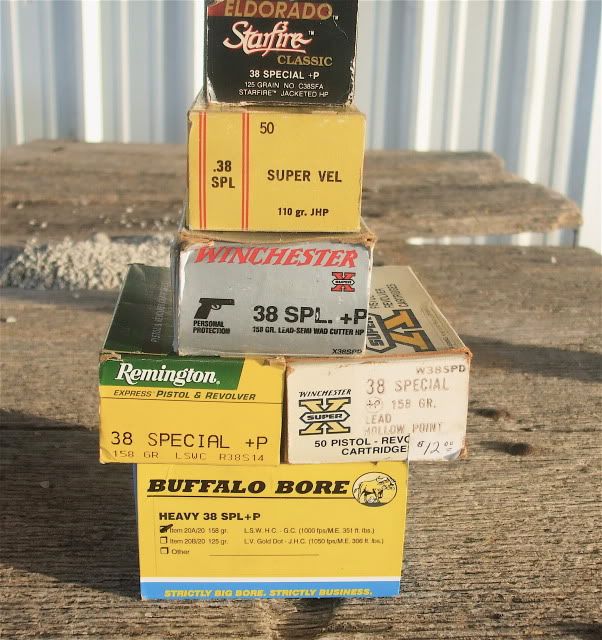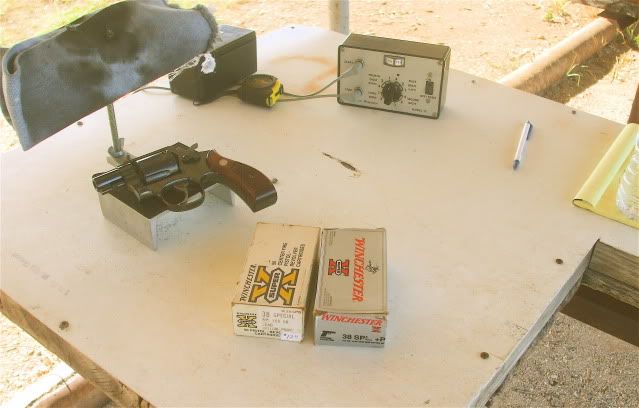Years ago I conducted a fairly extensive "chronographic survey" of the .38 Special, testing both a selection of handloads and factory loads. The results were recorded in a personal handloading manual. In referring back to the notes I found that the testing began on July 1, 1980.
I was recently digging through my stuff and found a couple of boxes of factory +P ammo from the era along with a box of heavy bullet handloads from the actual tests. I have additional boxes of my favorite .38 Special self defense loads on hand, along with a couple of boxes of the potent Buffalo Bore +P 158 grain SWC-HP load that I've been threatening to test, so determined to revisit the .38 Special. Here's the portion of the test that primarily involved the factory loads. It may take some time to test some additional handloads that are rolling around in my head and all might not find them interesting.
Have I mentioned that the Buffalo Bore +P 158 grain load is potent? Whoa! No need to ever attempt to build nuclear powered handloads with Buffalo Bore available.
This test is conducted in a very "scientific" manner. Since I'm not interested in incrementally sawing off my longest .38 Special revolver's barrel inch by inch, different revolvers were used for each barrel length recorded. This introduces a large variable. Also, since I didn't want to broil in the sun all afternoon, I appropriated the club's rifle range so as to sit in the shade and use a bench rest as a table. The rifle range faces west so has a long awning projection to help keep the sun out of shooters' eyes in the afternoon. This awning is of limited benefit but required that the screens to be set up 9 feet from the muzzles of the revolvers (well 8 feet, 3 5/8 inches from that long-snouted Model 14). We had a "cool spell" last week when the test was conducted and the afternoon high was 96F.
The chronograph used is the same Oehler Model 12 used 30 years ago.
List of Smith & Wesson revolvers used for these tests. All were chambered for the .38 Special except for the 6-inch gun which is a .357 Magnum.
Model 10: 2-inch
Model 10: Heavy Barrel: 4-inch
Military & Police: 5-inch
Model 27: .357 Magnum: 6-inch
Model 14: 8 3/8-inch
Except as noted, 10-shot strings were recorded. In some cases there was not enough ammo to provide for 50 rounds for each of the five revolvers. Muzzle velocity, muzzle energy, extreme spread, and standard deviation were examined (well, muzzle less 9 feet). Revolvers were used with barrel lengths of: 2, 4, 5, 6, and 8 3/8 inches.
Smith & Wesson officially proscribes using any of their revolvers made prior to 1958 with +P ammunition. The 5-inch gun was a real oldie so was not used with some of the ammunition on hand however it was tested with some of the +P ammunition. It handled 30 rounds of Remington and Winchester +P 158 grain ammunition with aplomb.
I still have 2 of the revolvers (the 4-inch and the 8 3/8-inch) which were used in July 1980 test and pressed them into service again. I also retested the boxes of factory loads and the handload which were tested at that time. These were: Winchester +P 158 grain SWC-HP, Super Vel 110 grain JHC, and a handload consisting of 9.5 grains of 2400 topped by a 200 grain Remington lead round nose bullet. The Super Vel is a partial box left from the last test 30 years ago. The Winchester +P is of that era. The handload with the 200 grain bullet was a part of the batch I loaded at the time of the first test in 1980.
Each barrel length will be featured in a separate post
Factory ammunition tested:
Independence 130 grain FMJ round nose
PMC El Dorado Starfire +P 125 grain JHP (apparently discontinued?)
Remington target 148 grain lead hollow based wadcutter
Winchester +P 158 grain lead SWC-HP (two different boxes)
Remington +P 158 grain lead SWC
Buffalo Bore +P 158 grain lead SWC-HP
Super Vel +P 110 grain JHP
Sellier & Bellot 158 grain FMJ flat point
Handloads:
158 grain lead round nose, 3.8 grains of Bullseye
200 grain Remington lead round nose, 9.5 grains 2400*
*Maximum load as published in older Lyman manual. Don't try it without working up carefully.
![Image]()
The +P line-up. Especially note the two different Winchester Western boxes of ammo tested. How old do y'all think that white box is? I just uncovered it in some stuff I was going through while getting the chronograph screens. It was a full unopened box. I'm remembering it as being from the late 1970s/early 1980s. It is marked $12.00.
![Image]()
Did I mention that Buffalo Bore .38 Special +P ammunition is red hot?
From their site:
S&W mod. 60, 2 inch- 1040 fps (379 ft. lbs.)
S&W mod. 66, 2.5 inch- 1059 fps (393 ft. lbs.)
Ruger SP101, 3 inch- 1143 fps (458 ft. lbs.)
S&W Mt. Gun, 4 inch- 1162 fps (474 ft. lbs.)
I was recently digging through my stuff and found a couple of boxes of factory +P ammo from the era along with a box of heavy bullet handloads from the actual tests. I have additional boxes of my favorite .38 Special self defense loads on hand, along with a couple of boxes of the potent Buffalo Bore +P 158 grain SWC-HP load that I've been threatening to test, so determined to revisit the .38 Special. Here's the portion of the test that primarily involved the factory loads. It may take some time to test some additional handloads that are rolling around in my head and all might not find them interesting.
Have I mentioned that the Buffalo Bore +P 158 grain load is potent? Whoa! No need to ever attempt to build nuclear powered handloads with Buffalo Bore available.
This test is conducted in a very "scientific" manner. Since I'm not interested in incrementally sawing off my longest .38 Special revolver's barrel inch by inch, different revolvers were used for each barrel length recorded. This introduces a large variable. Also, since I didn't want to broil in the sun all afternoon, I appropriated the club's rifle range so as to sit in the shade and use a bench rest as a table. The rifle range faces west so has a long awning projection to help keep the sun out of shooters' eyes in the afternoon. This awning is of limited benefit but required that the screens to be set up 9 feet from the muzzles of the revolvers (well 8 feet, 3 5/8 inches from that long-snouted Model 14). We had a "cool spell" last week when the test was conducted and the afternoon high was 96F.
The chronograph used is the same Oehler Model 12 used 30 years ago.
List of Smith & Wesson revolvers used for these tests. All were chambered for the .38 Special except for the 6-inch gun which is a .357 Magnum.
Model 10: 2-inch
Model 10: Heavy Barrel: 4-inch
Military & Police: 5-inch
Model 27: .357 Magnum: 6-inch
Model 14: 8 3/8-inch
Except as noted, 10-shot strings were recorded. In some cases there was not enough ammo to provide for 50 rounds for each of the five revolvers. Muzzle velocity, muzzle energy, extreme spread, and standard deviation were examined (well, muzzle less 9 feet). Revolvers were used with barrel lengths of: 2, 4, 5, 6, and 8 3/8 inches.
Smith & Wesson officially proscribes using any of their revolvers made prior to 1958 with +P ammunition. The 5-inch gun was a real oldie so was not used with some of the ammunition on hand however it was tested with some of the +P ammunition. It handled 30 rounds of Remington and Winchester +P 158 grain ammunition with aplomb.
I still have 2 of the revolvers (the 4-inch and the 8 3/8-inch) which were used in July 1980 test and pressed them into service again. I also retested the boxes of factory loads and the handload which were tested at that time. These were: Winchester +P 158 grain SWC-HP, Super Vel 110 grain JHC, and a handload consisting of 9.5 grains of 2400 topped by a 200 grain Remington lead round nose bullet. The Super Vel is a partial box left from the last test 30 years ago. The Winchester +P is of that era. The handload with the 200 grain bullet was a part of the batch I loaded at the time of the first test in 1980.
Each barrel length will be featured in a separate post
Factory ammunition tested:
Independence 130 grain FMJ round nose
PMC El Dorado Starfire +P 125 grain JHP (apparently discontinued?)
Remington target 148 grain lead hollow based wadcutter
Winchester +P 158 grain lead SWC-HP (two different boxes)
Remington +P 158 grain lead SWC
Buffalo Bore +P 158 grain lead SWC-HP
Super Vel +P 110 grain JHP
Sellier & Bellot 158 grain FMJ flat point
Handloads:
158 grain lead round nose, 3.8 grains of Bullseye
200 grain Remington lead round nose, 9.5 grains 2400*
*Maximum load as published in older Lyman manual. Don't try it without working up carefully.

The +P line-up. Especially note the two different Winchester Western boxes of ammo tested. How old do y'all think that white box is? I just uncovered it in some stuff I was going through while getting the chronograph screens. It was a full unopened box. I'm remembering it as being from the late 1970s/early 1980s. It is marked $12.00.

Did I mention that Buffalo Bore .38 Special +P ammunition is red hot?
From their site:
S&W mod. 60, 2 inch- 1040 fps (379 ft. lbs.)
S&W mod. 66, 2.5 inch- 1059 fps (393 ft. lbs.)
Ruger SP101, 3 inch- 1143 fps (458 ft. lbs.)
S&W Mt. Gun, 4 inch- 1162 fps (474 ft. lbs.)




